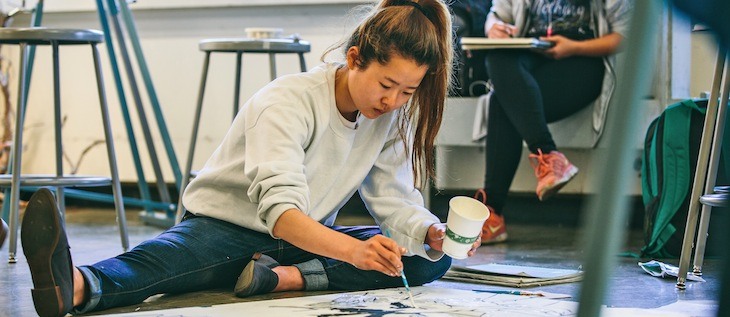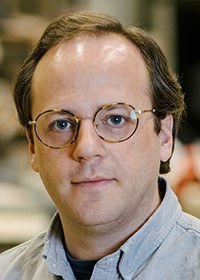UA School of Art names new interim director, shifting narrative around art degrees
by July 31, 2018 11:32 am 1,372 views

The University of Arkansas School of Art has not yet found its permanent director, but it has a new interim director – one of its own. Matthew McConnell will serve as interim director for the next academic year, the university announced Tuesday (July 31). A search will resume for a permanent director, to be in place by the fall of 2019.
The school was made possible by a $120 million grant from the Walton Family Charitable Foundation. That 2017 gift elevated the program from a department to a school of art. It is providing hundreds of thousands of dollars for scholarships, and it set forth performance metrics for the school.
A cultural shift is occurring both on campus and in the way art and design practices are being viewed in society – as generators for innovation, said Kayla Crenshaw, director of communications for the school of art.
The school and the Walton foundation are aligned on common goals: to change the narrative around art degrees, to integrate the arts program across campus, and to support K-12 students throughout the state both academically and creatively, she said. The old gut reaction of, ‘what will you do with an art degree’ is outdated and based on a lack of information about creative opportunities in the business world, Crenshaw said.
“If you talk with employers, one of the top five things they want in new hires is for them to be creative,” she said. “Even before the gift, enrollment in our graphic design program has tripled in recent years. We’re living in a culture that’s growing in the arts. There’s a very unique opportunity for us to set the stage for what you can do with an art degree.”
Finding a permanent director was thought to be the essential first step. The grant agreement had required the new director to be in place by January 2018, with a comprehensive strategic plan to be developed within his or her first 90 days to “operationalize all aspects of this proposal.”
Yet after a nationwide search and interviews this summer, Andrew Schulz was offered the position but instead took a position as dean of the University of Arizona School of Fine Arts.
“The Walton Family Charitable Foundation shares our principle – that we need to find the right person,” Crenshaw said. “We’ve maintained clear communications and we have been very blessed by their continued support in finding the right person to put in charge of this school.”
TRANSITIONAL GOALS
Crenshaw described McConnell as a reflective and thoughtful individual who received the unanimous support of the faculty before his appointment was forwarded to university leadership for approval. McConnell, in his seventh year at the UA, has been a ceramics professor and has taught Foundations, explorative courses to help all incoming art students determine a medium for their focus. McConnell will step away from teaching this year.

“I understand my time in the director’s chair to be transitional, and I simply want to make certain that when the new director is selected they are walking in the door fully confident they have inherited a thriving school with diverse programming, creative collaborations, inspiring outreach efforts, successful faculty and, of course, exceptional students,” McConnell said.
Jeannie Hulen, who served as interim director for the past year, will spend the next academic year teaching ceramics and engaging in research in Ghana, Africa as a Fulbright Scholar Award recipient. Hulen was a driving force during the past year, offering fresh ideas and strong leadership, Crenshaw said.
The university also announced Marty Maxwell Lane as interim associate director for the academic year. An assistant professor in graphic design, Lane has taught at the UA for four years and will retain some teaching responsibilities. Her role will be administrative and development support for McConnell, faculty, staff and students.
McConnell said the upcoming year will be exciting, with “increased opportunities and support for our students at the undergraduate and graduate levels, new collaborations and outreach projects, strengthened partnerships with Crystal Bridges Museum of American Art and other arts institutions in the region, faculty research projects, and visits and lectures from some of the country’s best artist, historians, and designers, among many other things.”
PERSPECTIVE
During this past summer’s interview for the director position, the four candidates had described challenges and opportunities they had identified. They acknowledged the school’s culture is already strong and cohesive and that the extraordinary financial opportunity had come along while many other art schools are experiencing budget cuts. But “it’s not unheard of to spend vast sums of money and still lose the moment at hand,” said James Haywood Rolling Jr. of Syracuse University.
Hiring first-rate faculty shouldn’t prove a challenge, the candidates agreed, but integrating them quickly could be.
“Rapid growth can be energizing and exhausting,” candidate Elizabeth “Cassie” Mansfield had said.
Meeting metrics of the gift could be daunting, the candidates had acknowledged, particularly positioning a new art history program within the top 25 schools in the country within 10 years. Rolling was not offered the position, but his academic background had been described as “enviable and massive” when he was introduced by Lynda Coon, dean of the UA Honor’s College.
“Yet in all those years of service, I never encountered an opportunity like this,” Rolling had said.
